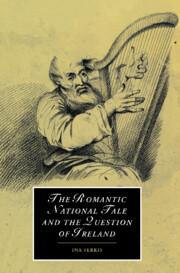Book contents
- Frontmatter
- Contents
- Acknowledgments
- Introduction: the awkward space of Union
- 1 Civic travels: the Irish tour and the new United Kingdom
- 2 Public address: the national tale and the pragmatics of sympathy
- 3 Female agents: rewriting the national heroine in Morgan's later fiction
- 4 The shudder of history: Irish Gothic and ruin writing
- 5 Agitated bodies: the Emancipation debate and novels of insurgency in the 1820s
- Notes
- Bibliography
- Index
- CAMBRIDGE STUDIES IN ROMANTICISM
4 - The shudder of history: Irish Gothic and ruin writing
Published online by Cambridge University Press: 22 September 2009
- Frontmatter
- Contents
- Acknowledgments
- Introduction: the awkward space of Union
- 1 Civic travels: the Irish tour and the new United Kingdom
- 2 Public address: the national tale and the pragmatics of sympathy
- 3 Female agents: rewriting the national heroine in Morgan's later fiction
- 4 The shudder of history: Irish Gothic and ruin writing
- 5 Agitated bodies: the Emancipation debate and novels of insurgency in the 1820s
- Notes
- Bibliography
- Index
- CAMBRIDGE STUDIES IN ROMANTICISM
Summary
In Rome there are many distinguished men concerned only with discovering new relationships between history and the ruins.
Germaine de Stael Corinne (1807)Ruin, as with earthquake shock, is here.
Anna Laetitia Barbauld England in Eighteen Eleven (1812)Charles Robert Maturin's little-known The Milesian Chief (1812) moved the national tale plot established by The Wild Irish Girl, along with Stael's performing heroine, into a limit zone, producing itself as a limit text in the process and inaugurating the genre known as Irish Gothic or Protestant Gothic. “If I possess any talent,” Maturin wrote in the Dedication to this novel, “it is that of darkening the gloomy, and of deepening the sad; of painting life in extremes, and representing those struggles of passion when the soul trembles on the verge of the unlawful and the unhallowed.” The significant point of the passage is not so much extremity as negativity: this is a writing that recognizes itself as a form of undoing and that is drawn to the peculiar space of negation signalled by the privative: “unlawful,” “unhallowed.” It is entirely characteristic that Maturin's reading of Corinne – in contrast to that of Morgan – concentrates on the desolate second half of the novel. Morgan was attracted to the first part of Stael's text with its prominent motif of female performance, and she rewrote the notion of performance in pragmaticfeminist terms as a setting of screens behind which potential spaces for action could be cleared, as well as exits secured.
- Type
- Chapter
- Information
- The Romantic National Tale and the Question of Ireland , pp. 102 - 126Publisher: Cambridge University PressPrint publication year: 2002

